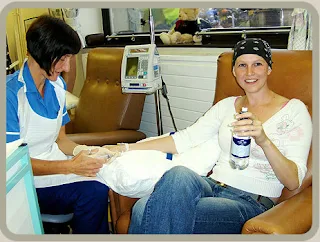Did you know that Breast cancer is a cancer that starts in the tissues of the breast?
Did you know there are two main types of breast cancer?
- Ductal carcinoma starts in the tubes (ducts) that move milk from the breast to the nipple. Most breast cancers are of this type.
- Lobular carcinoma starts in parts of the breast, called lobules, that produce milk.
DidMany breast cancers are sensitive to the hormone estrogen. This means that estrogen causes the breast cancer tumor to grow. Such cancer is called estrogen receptor positive cancer or ER positive cancer.
Some women have what's called HER2-positive breast cancer. HER2 refers to a gene that helps cells grow, divide, and repair themselves. When cells have too many copies of this gene, cells -- including cancer cells -- grow faster. Experts think that women with HER2-positive breast cancer have a more aggressive disease and a higher risk of recurrence than those who do not have this type.
Early breast cancer usually does not cause symptoms. This is why regular breast exams are important. As the cancer grows, symptoms may include:
Did you know that men get breast cancer, too?
Symptoms include breast lump and breast pain and tenderness.
Symptoms of advanced breast cancer may include:
- Breast lump or lump in the armpit that is hard, has uneven edges, and usually does not hurt
- Change in the size, shape, or feel of the breast or nipple -- for example, you may have redness, dimpling, or puckering that looks like the skin of an orange
- Fluid coming from the nipple -- may be bloody, clear to yellow, green, and look like pus
Did you know that men get breast cancer, too?
Symptoms include breast lump and breast pain and tenderness.
Symptoms of advanced breast cancer may include:
Treatment is based on many factors, including type and stage of the cancer, whether the cancer is sensitive to certain hormones, and whether or not the cancer overproduces (overexpresses) a gene called HER2/neu.
In general, cancer treatments may include:
Targeted therapy, also called biologic therapy, is a newer type of cancer treatment. This therapy uses special anticancer drugs that identify certain changes in a cell that can lead to cancer. One such drug is trastuzumab (Herceptin). For women with stage IV HER2-positive breast cancer, Herceptin plus chemotherapy has been shown to be work better than chemotherapy alone. Studies have also shown that in women with early stage HER2-positive breast cancer, this medicine plus chemotherapy cuts the risk of the cancer coming back by 50%.
Cancer treatment may be local or systemic.
In general, cancer treatments may include:
- Chemotherapy medicines to kill cancer cells
- Radiation therapy to destroy cancerous tissue
- Surgery to remove cancerous tissue -- a lumpectomy removes the breast lump; mastectomy removes all or part of the breast and possible nearby structures
- Hormonal therapy to block certain hormones that fuel cancer growth
- Targeted therapy to interfere with cancer cell growth and function
Targeted therapy, also called biologic therapy, is a newer type of cancer treatment. This therapy uses special anticancer drugs that identify certain changes in a cell that can lead to cancer. One such drug is trastuzumab (Herceptin). For women with stage IV HER2-positive breast cancer, Herceptin plus chemotherapy has been shown to be work better than chemotherapy alone. Studies have also shown that in women with early stage HER2-positive breast cancer, this medicine plus chemotherapy cuts the risk of the cancer coming back by 50%.
Cancer treatment may be local or systemic.
- Local treatments involve only the area of disease. Radiation and surgery are forms of local treatment.
- Systemic treatments affect the entire body. Chemotherapy is a type of systemic treatment.
- Stage 0 and DCIS -- Lumpectomy plus radiation or mastectomy is the standard treatment. There is some controversy on how best to treat DCIS.
- Stage I and II -- Lumpectomy plus radiation or mastectomy with some sort of lymph node removal is standard treatment. Hormone therapy, chemotherapy, and biologic therapy may also be recommended following surgery.
- Stage III -- Treatment involves surgery possibly followed by chemotherapy, hormone therapy, and biologic therapy.
- Stage IV -- Treatment may involve surgery, radiation, chemotherapy, hormonal therapy, or a combination of such treatments.
Did you know that Over the course of a lifetime, 1 in 8 women
will be diagnosed with breast cancer?
Did you know these Risk factors that you cannot change, include:
There is no evidence of a direct link between breast cancer and pesticides.
The National Cancer Institute provides an online tool to help you figure out your risk of breast cancer. See: www.cancer.gov/bcrisktool
will be diagnosed with breast cancer?
Did you know these Risk factors that you cannot change, include:
- Age and gender -- Your risk of developing breast cancer increases as you get older. The majority of advanced breast cancer cases are found in women over age 50. Women are 100 times more likely to get breast cancer then men.
- Family history of breast cancer -- You may also have a higher risk for breast cancer if you have a close relative who has had breast, uterine, ovarian, or colon cancer. About 20 - 30% of women with breast cancer have a family history of the disease.
- Genes -- Some people have genes that make them more prone to developing breast cancer. The most common gene defects are found in the BRCA1 and BRCA2 genes. These genes normally produce proteins that protect you from cancer. But if a parent passes you a defective gene, you have an increased risk for breast cancer. Women with one of these defects have up to an 80% chance of getting breast cancer sometime during their life.
- Menstrual cycle -- Did you know that women who get their periods early (before age 12) or went through menopause late (after age 55) have an increased risk for breast cancer?
- Alcohol use -- Drinking more than 1 - 2 glasses of alcohol a day may increase your risk for breast cancer.
- Childbirth -- Women who have never had children or who had them only after age 30 have an increased risk for breast cancer. Being pregnant more than once or becoming pregnant at an early age reduces your risk of breast cancer.
- DES -- Women who took diethylstilbestrol (DES) to prevent miscarriage may have an increased risk of breast cancer after age 40. This drug was given to the women in the 1940s - 1960s.
- Hormone replacement therapy (HRT) -- You have a higher risk for breast cancer if you have received hormone replacement therapy for several years or more. Many women take HRT to reduce the symptoms of menopause.
- Obesity -- Obesity has been linked to breast cancer, although this link is controversial. The theory is that obese women produce more estrogen, which can fuel the development of breast cancer.
- Radiation -- If you received radiation therapy as a child or young adult to treat cancer of the chest area, you have a significantly higher risk for developing breast cancer. The younger you started such radiation, the higher your risk -- especially if the radiation was given when a female was developing breasts.
There is no evidence of a direct link between breast cancer and pesticides.
The National Cancer Institute provides an online tool to help you figure out your risk of breast cancer. See: www.cancer.gov/bcrisktool
The doctor will ask you about your symptoms and risk factors, and then perform a physical exam, which includes both breasts, armpits, and the neck and chest area. Additional tests may include:
Breast cancer stages range from 0 to IV. Breast cancer that has not spread is called ductal carcinoma in situ (DCIS), or noninvasive breast cancer. If it spreads, the cancer is called invasive breast cancer. The higher the number, the more advanced the cancer.
- Mammography to help identify the breast lump
- Breast MRI to help better identify the breast lump
- Breast ultrasound to show whether the lump is solid or fluid-filled
- Breast biopsy, needle aspiration, or breast lump removal to remove all or part of the breast lump for closer examination by a laboratory specialist
- CT scan
- Sentinal lymph node biopsy
- PET scan
Breast cancer stages range from 0 to IV. Breast cancer that has not spread is called ductal carcinoma in situ (DCIS), or noninvasive breast cancer. If it spreads, the cancer is called invasive breast cancer. The higher the number, the more advanced the cancer.
How well you do after being treated for breast cancer depends on many things. The more advanced your cancer, the poorer the outcome.
The 5-year survival rate refers to the number of patients who live at least 5 years after their cancer is found. According to the American Cancer Society (ACS), the 5-year survival rates for persons with breast cancer who are appropriately treated are as follows:
The 5-year survival rate refers to the number of patients who live at least 5 years after their cancer is found. According to the American Cancer Society (ACS), the 5-year survival rates for persons with breast cancer who are appropriately treated are as follows:
- 100% for stage 0
- 100% for stage I
- 92% for stage IIA
- 81% for stage IIB
- 67% for stage IIIA
- 54% for stage IIIB
- 20% for stage IV
Many risk factors -- such as your genes and family history -- cannot be controlled. However, a healthy diet 
and a few lifestyle changes may reduce your overall chance of cancer in general.Breast cancer is more easily treated and often curable if it is found early.
Early detection involves:
Did you know that women between the ages 20 and 39 should have a doctor examine their breasts at least once every 3 years.
Did you know after age 40:
Certain women at high risk for breast cancer may have a breast MRI along with their yearly mammogram. Ask your doctor if you need an MRI.
Screening for breast cancer is a topic filled with controversy. A woman needs to have an informed and balanced discussion with her doctor, along with doing additional reading and researching on her own, to determine if mammography is right for her.
Tamoxifen is approved for breast cancer prevention in women aged 35 and older who are at high risk.
Women at very high risk for breast cancer may consider preventive (prophylactic) mastectomy, which is the surgical removal of the breasts. Possible candidates for this procedure may include those who have already had one breast removed due to cancer, women with a strong family history of breast cancer, and persons with genes or genetic mutations that raise their risk of breast cancer.

Early detection involves:
- Breast self-exams (BSE)
- Clinical breast exams by a medical professional
- Screening mammography
Did you know that women between the ages 20 and 39 should have a doctor examine their breasts at least once every 3 years.
Did you know after age 40:
- Women 40 and older should have a mammogram every 1 - 2 years, depending on their risk factors. Women should call their doctor immediately if they notice in change in their breasts whether or not they do routine breast self-exams.
- Women 40 and older should have a complete breast exam by a health care provider every year.
Certain women at high risk for breast cancer may have a breast MRI along with their yearly mammogram. Ask your doctor if you need an MRI.
Screening for breast cancer is a topic filled with controversy. A woman needs to have an informed and balanced discussion with her doctor, along with doing additional reading and researching on her own, to determine if mammography is right for her.
Tamoxifen is approved for breast cancer prevention in women aged 35 and older who are at high risk.
Women at very high risk for breast cancer may consider preventive (prophylactic) mastectomy, which is the surgical removal of the breasts. Possible candidates for this procedure may include those who have already had one breast removed due to cancer, women with a strong family history of breast cancer, and persons with genes or genetic mutations that raise their risk of breast cancer.
New, improved treatments are helping persons with breast cancer live longer than ever before. However, even with treatment, breast cancer can spread to other parts of the body. Sometimes, cancer returns even after the entire tumor is removed and nearby lymph nodes are found to be cancer-free.
You may experience side effects or complications from cancer treatment. For example, radiation therapy may cause temporary swelling of the breast, and aches and pains around the area. Ask your doctor about the side effects you may have during treatment.
You may experience side effects or complications from cancer treatment. For example, radiation therapy may cause temporary swelling of the breast, and aches and pains around the area. Ask your doctor about the side effects you may have during treatment.
Contact your health care provider for an appointment if:
- You have a breast or armpit lump
- You are a woman age 40 or older and have not had a mammogram in the last year
- You are a woman age 35 or older and have a mother or sister with breast cancer, or have already had cancer of the breast, uterus, ovary, or colon.
- You do not know how or need help learning how to perform a breast self-examination

Now if you didn't know, now you know...
To see more did you know that trivia click here
























